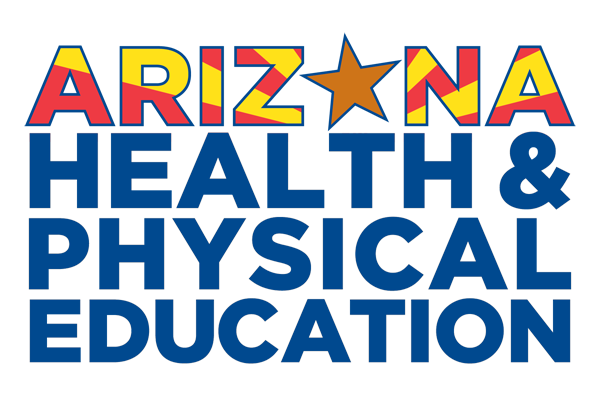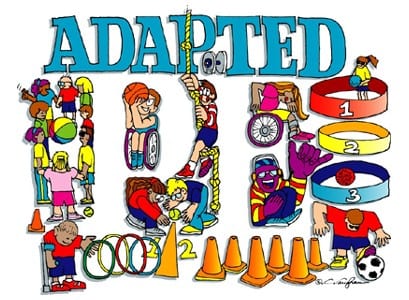Greetings Arizona Health and Physical Educators!
Our last blog focused on what adapted physical educators actually do. This month the
hope is to clarify what adapted physical education is. Over the years I have heard many
misconceptions about how a student qualifies for adapted physical education as well as
what the actual purpose of adapted physical education is.
To begin I’d like to clear up one misnomer. If you notice above, the word used is
‘ADAPTED’ physical education rather than adaptive physical education. What’s the
difference? I’m so glad you asked!
The terms “adapted” and “adaptive” should never be used interchangeably when
describing specially designed physical education services (Sherrill, 1998). “Adaptive” is
a term that describes behaviors, skills or functions. The goal for specially designed
physical education services is to modify equipment, rules, environment or instruction to
best suit the child's needs, not to change the student.
So what is adapted physical education?
Adapted Physical Education is physical education which has been adapted or modified,
so that it is as appropriate for the person with a disability as it is for a person without a
disability.
Federal law mandates that physical education be provided to students with disabilities
and defines Physical Education as the development of:
● physical and motor skills
● fundamental motor skills and patterns (throwing, catching, walking, running,
etc)
● skills in aquatics, dance, and individual and group games and sports
(including intramural and lifetime sports)
The Individuals with Disabilities Education Act (1990) uses the term disability as a
diagnostic category that qualifies students for special services. These categories
include:
● Autism
● Deaf – Blindness
● Deafness
● Hearing impairment
● Intellectual disability
● Multiple disabilities
● Orthopedic impairment
● Other health impairment
● Serious emotional disturbance
● Specific learning disability
● Speech or language impairment
● Traumatic brain injury
● Visual impairment including blindness
The services provided by an APE teacher can include (adapted from Sherrill, 1998):
● Planning services
● Assessment of Individuals /Ecosystems
● Prescription/Placement: The IEP
● Teaching/Counseling/Coaching
● Evaluation of Services
● Coordination of Resources and Consulting
● Advocacy
The APE teacher is a direct service provider, not a related service provider, because
physical education for children with disabilities is a federally mandated component of
special education services [U.S.C.A. 1402 (25)]. This means that physical education
needs to be provided to the student with a disability as part of the special education
services that child and family receive. This is contrasted with physical therapy and
occupational therapy, which are related services. These therapies are provided to the
child with disabilities only if he/she needs them to benefit from instruction.
The IEP team determines whether a student requires adapted physical education or is
able to participate in regular physical education. Federal Regulations under IDEA
(300.108) states: “Physical education services, specially designed if necessary, must be
made available to every child with a disability receiving FAPE, unless the public agency
enrolls children without disabilities and does not provide physical education to children
without disabilities in the same grades. Each child with a disability must be afforded the
opportunity to participate in the regular physical education program available to non-
disabled children unless: (1) the child is enrolled full time in a separate facility; or (2) the
child needs specially designed physical education, as prescribed in the child’s IEP.”
When developing an IEP, regular PE would be the first consideration. If necessary, the
team would next consider regular PE with accommodations or modifications to the
curriculum and/or performance expectations. If these two models are not appropriate,
the team may determine that adapted PE services are necessary in the child’s IEP to
assist the student in a parallel physical education curriculum. Adapted physical
education is not a related service. Related services, such as OT and PT cannot be
considered a substitute for physical education. In addition, adapted physical education
is not a substitute for general physical education. Instead, adapted physical education is
in addition to the general physical education class.
The individual providing the adapted physical education should collaborate with the
occupational therapist, the physical therapist, the special education teacher, parents
and/or the physical education teacher to meet the child’s needs related to:
● health and safety, including specific medical needs
● modifications of equipment or the environment.
● specific sensorimotor programming
● specific play or leisure needs
● activities of daily living related to physical education such as dressing, showering
or toileting
● positioning during exercises and games
● access to the general curriculum
Adapted physical educators are not medical personnel nor are they behavior specialists.
In order for a child to qualify for adapted physical education in Mesa Public Schools, the
evaluator (adapted physical education specialist) must observe motor skill deficits in
one or more of the fundamental motor skill areas (locomotor and/or object control) and
the student must score at least one standard deviation from the mean on the Adapted
Physical Education Assessment Scale (APEAS II) evaluation and 1.5 standard deviation
points away from the mean on the Test of Gross Motor Development (TGMD-2). The
APEAS results are compared with students/peers with the same disability and same
age, while the TGMD-2 results are compared with the general education population of
the same age.
Although adapted physical educators are trained in the use of behavior management
strategies, such as visuals, communication boards, visual schedules, a structured
routine and various sensory tools, they are not behavior specialists and students do not
qualify for adapted physical education services because of behaviors.
Once a student qualifies for adapted physical education, the IEP team will determine the
appropriate placement, whether that be in general physical education with modifications
and/or accommodations, a small group of students working on specific IEP goals,
modified or unified physical education. Both modified and unified physical education
tend to be classes at the secondary level (not always, but typically).
In Mesa, at the elementary level, the adapted physical education specialists will work
with students in both a small group environment and the general physical education
class. While in the small group setting, the APE teachers will focus on individual IEP
goals as well as common procedures (freeze with hands on knees, eyes on the teacher;
waiting their turn; handling equipment) and fundamental skills such as running,
galloping, skipping, throwing, catching, etc. The goal is to prepare all students to be
able to successfully participate in the general physical education class with their same
age peers.
When students transition from elementary school to secondary, their services may
change, depending on what is offered in each school. For example, many junior high
and high schools are offering modified and/or unified physical education classes.
In the next blog we will discuss the various types of services and placements for
students receiving adapted physical education services.
If you have specific questions, please feel free to reach out to Arizona Health and
Physical Education or your favorite adapted physical educator!
Lastly, don’t forget to register for the Adapted Physical Education Conference,
happening on February 16th at Ability360 in Phoenix. Register today and be sure to
choose your lunch option!
Cheers!

